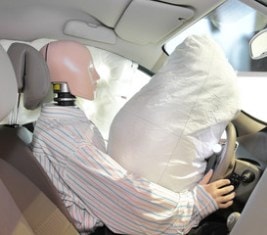The newest cars on the road today not only offer great performance, they’re using the latest technological advancements to keep drivers and passengers safe. Collision warning systems and backup cameras can help you avoid a crash, and innovations such as airbags help reduce injuries in a wreck. It’s important to know and understand these safety technologies found in automobiles. 
Airbags
- Front airbags. Standard on all new passenger vehicles since 1999, front airbags inflate quickly in the event of a collision. While airbags have saved countless lives, they do have the potential to injure children and adults who aren’t using a seatbelt. Therefore, children 11 years of age and under should use a restraint system appropriate for their age and should be seated in the rear of the vehicle. To improve airbag safety, dual-stage front airbags were standard in all passenger vehicles by the 2007 model year. These systems adjust pressure within the airbag and allow the airbag to deploy with only moderate force in less severe collisions, reducing the risk of passenger injury from the airbag itself. Of course, in the worst accidents, the airbag will still deploy with maximum force. Airbag systems can now measure the weight and seat position of the driver and front passenger and deactivate airbags when appropriate to prevent injury.
- Side airbags. Front-seat side airbags are now nearly universal, and many vehicles offer side airbags for rear-seat passengers, as well. They are effective at protecting the torso, but most still leave the head susceptible to injury. Therefore, nearly all new cars now include side curtain airbags. These deploy from above the windows, covering both the front and rear side windows to protect occupants from hitting their heads. These bags also prevent people from being thrown from the vehicle during a crash.
Anti-Lock Braking Systems (ABS), Traction Control, and Electronic Stability Control
Anti-lock braking systems use sensors at each wheel to determine how much braking action is necessary. Prior to ABS, drivers would often lock up their wheels during hard braking. This made it impossible to steer and dramatically increased the chances of an accident. ABS prevents this, allowing the car to be maneuvered around any obstacles in the road.
Traction control limits wheel spin, so your vehicle’s tires can maintain traction. This is especially valuable in wet or icy conditions. Electronic stability control further enhances traction control by preventing the vehicle from sliding through a turn, and it became standard equipment on all cars in 2012. If the car begins to slide, the stability-control system will apply braking force to bring the vehicle back on track. This is particularly useful for drivers of top-heavy vehicles such as sport-utility vehicles and pickup trucks, since it can help prevent rollover accidents.
Forward-Collision Warning Systems and Backup Cameras
Forward-collision warning systems use cameras, radar, or lasers to alert the driver when he is approaching the vehicle in front too quickly, in order to prevent a collision. These systems typically use a visual or audible signal to alert the driver to a potential accident.
Beginning with the 2018 model year, all passenger vehicles will offer rear-view cameras. These systems are activated automatically when the vehicle’s transmission is shifted into reverse. The rear view is displayed on a screen in the center console, helping drivers spot children and pedestrians in the blind zone directly behind the vehicle.
Adaptive Cruise Control and Lane-Keeping Systems
Adaptive cruise control, cameras, lasers, and radar are used to maintain a set distance between your vehicle and the car in front. This can make it easy to maintain a safe following distance automatically, with some systems even bringing a vehicle to a complete stop, if necessary. Lane-keeping systems use cameras and lasers to determine whether or not the vehicle is within the lane markings and apply a gentle steering input to guide you back into your lane.
You Need an Attorney
Even the most advanced safety technologies can’t completely eliminate human error. If you’ve been injured in a vehicle accident due to the negligence of another driver, you deserve compensation for the harm you’ve suffered. You need professional representation by an experienced attorney who is ready to fight for you. To learn more, contact the vehicle accident attorneys of Kearney, Freeman, Fogarty & Joshi, PLLC by using the form on this page.
|
Related links: |

